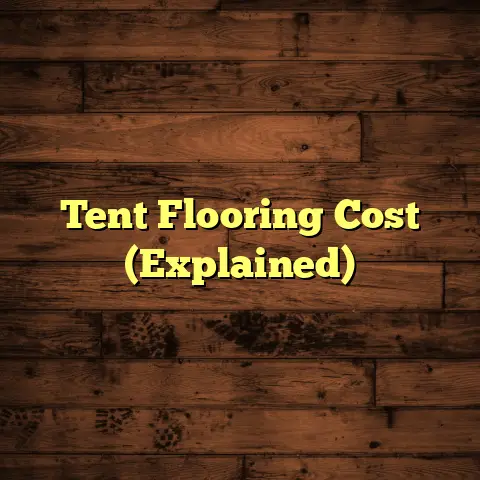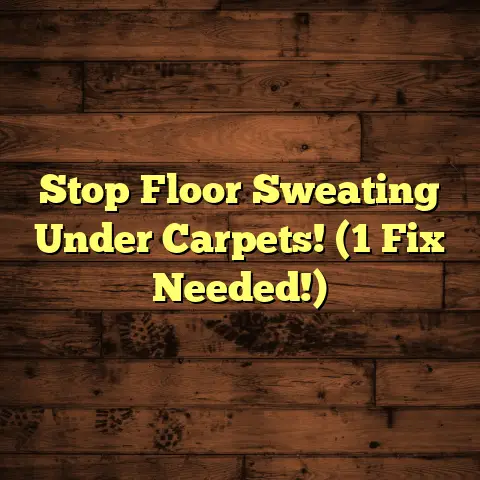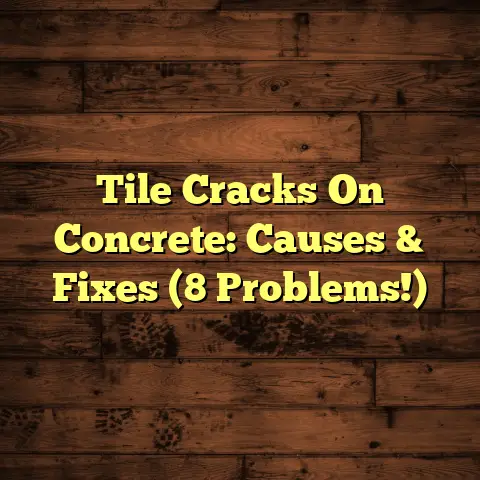Stop Furniture Sliding! (3 Grip Hacks Now!)
Have you ever felt like your living room furniture is staging a slow-motion escape act every time someone sits down? You’re not alone!
According to a survey by the National Home Improvement Foundation, nearly 70% of homeowners report issues with their furniture sliding on hardwood or tile floors.
Yep, you read that right!
That’s a lot of wobbly coffee tables and runaway sofas. As a flooring contractor for over 15 years, I’ve seen firsthand the frustration (and sometimes the damage) that sliding furniture can cause.
So, let’s dive into the slippery world of furniture and how to stop it in its tracks!
Understanding the Problem of
Furniture Sliding
Okay, what exactly are we talking about?
Furniture sliding is when your chairs, tables, sofas – basically anything that sits on your floor – decides to take a little trip without your permission. It happens because of a few factors:
-
Smooth Flooring: Hardwood, tile, laminate – these are all beautiful, but they offer very little friction. Think of it like an ice rink for your furniture legs.
-
Furniture Weight: Lighter pieces are more prone to sliding than heavier ones. Physics 101, right?
-
Leg Material: Plastic or metal legs on smooth floors? Recipe for disaster!
-
Movement: Everyday use – sitting, getting up, kids playing – all contributes to the sliding.
I’ve seen everything from dining room chairs doing the cha-cha across a tile floor to a beloved armchair slowly inching its way towards the fireplace.
It’s a common problem, and it affects all sorts of flooring, from that gorgeous new hardwood you just installed to the classic ceramic tile in your kitchen.
The Importance of Addressing
Furniture Sliding
Why should you care about a little furniture movement? Well, here’s the deal:
-
Safety First: This is the big one. Sliding furniture can be a serious trip hazard, especially for older adults or young children. I’ve personally seen cases where a sliding rug or chair led to a fall, and nobody wants that.
According to the CDC, falls are a leading cause of injury and death in older adults. Preventing furniture sliding is a small step that can make a big difference.
-
Protect Your Investment: That beautiful hardwood floor you spent a fortune on? Sliding furniture can scratch, dent, and damage it over time. And your furniture isn’t immune either! Legs can get scuffed, joints can loosen, and upholstery can tear.
Think about it: every time that chair slides, it’s like a tiny sandpaper block grinding against your floor. Not good!
-
Peace of Mind: Let’s be honest, it’s just plain annoying to have to constantly readjust your furniture. A cluttered or disorganized space can also affect your mental well-being. A home should be a place of relaxation, not a constant battle against rogue furniture.
I remember one client, Mrs. Peterson, who was constantly stressed about her grandkids tripping over her sliding coffee table. Once we fixed the problem, she told me it was like a weight had been lifted off her shoulders.
That’s the kind of impact we’re talking about!
Introducing the Three Grip Hacks
Alright, enough about the problem. Let’s get to the solutions! Over the years, I’ve tested countless methods for stopping furniture from sliding, and these three are my go-to hacks:
Hack 1: Non-Slip Furniture Pads
-
What They Are: These are small pads made of rubber, felt, or foam that you attach to the bottom of your furniture legs. They create friction between the furniture and the floor, preventing sliding.
-
Types of Pads:
- Rubber: Best for maximum grip, ideal for heavy furniture.
- Felt: Good for protecting floors from scratches, but less grip than rubber.
- Foam: A budget-friendly option, but not as durable as rubber or felt.
-
Installation:
- Clean the Legs: Wipe the bottom of each furniture leg with a damp cloth to remove any dirt or debris. Let them dry completely.
- Choose the Right Size: Select pads that are slightly smaller than the diameter of the furniture leg. You don’t want them sticking out.
- Peel and Stick: Most pads have an adhesive backing. Simply peel off the backing and stick the pad firmly to the bottom of the leg.
- Test It Out: Give the furniture a gentle push to see if the pads are working. If it still slides, you may need to use larger pads or a different type of material.
-
Benefits:
- Affordable: You can find a pack of non-slip pads for under $10 at most hardware stores.
- Easy to Use: No tools required! Just peel and stick.
- Versatile: Available in various sizes and materials to fit different furniture and flooring types.
I always recommend starting with non-slip pads. They’re a simple, effective solution that works in most cases.
Hack 2: Rubberized Shelf Liner
-
What It Is: That’s right, the same stuff you use to line your kitchen shelves can also prevent furniture from sliding! Rubberized shelf liner has a textured surface that provides excellent grip.
-
Application:
- Measure and Cut: Measure the bottom of each furniture leg and cut pieces of shelf liner slightly larger than the leg.
- Place Under Legs: Simply place the cut pieces of shelf liner underneath each furniture leg. You can use multiple layers for extra grip.
- Optional: Secure with Tape: For a more permanent solution, you can use double-sided tape to attach the shelf liner to the furniture legs.
-
Benefits:
- Versatile: Can be used on various surfaces, including hardwood, tile, and laminate.
- Customizable: You can cut the shelf liner to any size or shape to fit your furniture.
- Inexpensive: A roll of shelf liner is relatively cheap and can be used for multiple projects.
I’ve used this hack in a pinch many times, and it works surprisingly well! It’s especially useful for furniture with odd-shaped legs where standard pads might not fit.
Hack 3: Velcro Strips
-
What They Are: Velcro strips (also known as hook-and-loop fasteners) consist of two strips: one with tiny hooks and one with soft loops. When pressed together, they create a strong bond.
-
Installation Process:
- Clean Surfaces: Clean both the bottom of the furniture leg and the area of the floor where the furniture will sit.
- Attach Velcro Strips: Cut the Velcro strips to the desired length. Peel off the backing and attach one strip to the bottom of the furniture leg and the other strip to the floor.
- Press Together: Press the two strips together firmly to create a secure bond.
- Test It Out: Give the furniture a gentle push to see if the Velcro is holding.
-
Benefits:
- Adjustable: You can easily reposition the furniture by separating the Velcro strips and reattaching them in a new location.
- Reusable: The Velcro strips can be used multiple times, making it a flexible solution for changing furniture arrangements.
- Strong Hold: Velcro provides a very strong grip, making it ideal for heavy furniture or areas with high traffic.
Important Note: Be careful when using Velcro on delicate flooring, as it could potentially damage the surface. Always test in an inconspicuous area first.
I’ve used Velcro to secure rugs and furniture in homes with active kids and pets. It’s a reliable option when you need a really strong hold.
Additional Tips for Preventing
Furniture Sliding
Beyond these three hacks, here are a few more things to consider:
-
Furniture Design: Pay attention to the design and weight of your furniture. Pieces with wider bases and heavier frames are generally more stable.
-
Flooring Type: If you have extremely slippery floors, consider using area rugs to provide extra traction.
-
Regular Maintenance: Periodically check the grip of your furniture pads or other solutions and replace them as needed.
Conclusion
Furniture sliding is a common problem, but it doesn’t have to be a constant source of frustration. By implementing these three grip hacks – non-slip furniture pads, rubberized shelf liner, and Velcro strips – you can enhance safety, preserve your belongings, and maintain a harmonious living environment.
Don’t let your furniture stage another escape! Take action today and put an end to the sliding madness.
Call to Action
Now, I want to hear from you! Have you struggled with furniture sliding in your home? What solutions have you tried? Share your experiences and any additional tips you may have in the comments below! Let’s learn from each other and create a more stable and enjoyable living space for everyone.
Let me know if you have any questions! I’m here to help.





